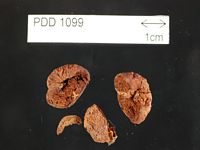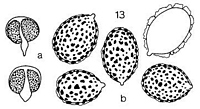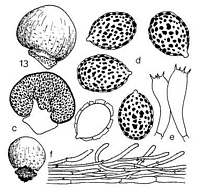|
 Cortinarius cartilagineus Cortinarius cartilagineus
SynonymsThaxterogaster cartilagineus
Secotium cartilagineum
BiostatusPresent in region - Indigenous. Non endemic
Images (click to enlarge)
Caption: Dried type specimen
Owner: Herb PDD | 
Caption: Thaxterogaster cartilagineum (Cunningham) Moser (holotype):
a. fruitingbodies (sec. Cunningham). b. spores. | 
Caption: Thaxterogaster
cartilagineum (Cunningham) Moser (ZT 67/171):
c.
fruitingbodies. d. spores. c. basidia. f. cuticle. |
Article: Horak, E. (1973). Fungi Agaricini Novazelandiae I-V. Beihefte zur Nova Hedwigia 43: 200 p.
Description: Gastrocarp
5-40 x 15-30 mm, globose or depressed globose, peridium up to 2 mm diam., enrolled
towards the margin and dehiscent from upper parts of the marginate base of the
stipe, excavated, ochraceous to deep apricot yellow (especially at the centre),
paler on drying, densely covered with fibrillose, concolorous squamules of the
veil, scabrid, dry. Gleba cellular, chambers oval, up to 3 mm diam., irregularly
arranged, exposed only in aged carpophores, rust brown. Stipe (columella) absent
or obliquely developed, -30 x 2-3(-22) mm, base of stipe marginate, turbiniform,
columella tapering towards the apex and emerging into the peridium or irregularly
branched or lacking altogether, base of stipe concolorous with peridium, squamulose
from remnants of the veil. Context whitish to yellow-brown. Odor and taste not
distinctive. Chemical reactions on peridium: KOH - brown; HCl - yellowish; NH3
- negative.
Spores
12-15 x 8,5 µm, broadly ovate, coarsely warted, perisporium well developed,
axially symmetric, ferruginous. Basidia 35-50 x 10-12 µm, 4-spored Cystidia
absent. Epicutis consisting of cylindric, repent, not gelatinised hyphae (3-12
µm diam.) forming a cutis, membranes encrusted with brownish pigment. Clamp
connections present
Habitat: On
ground under Nothofagus spp. and Leptospermum scoparium. New Zealand.
Notes: The
description has been drawn from the type and from two fresh collections made
in the beech forests of South Island. The macroscopic characters of this species
are well described by Cunningham who says that the peridium in appearance and
to the touch closely resembles chamois leather. However, it seems that Cunningham
never saw this fungus in fresh condition because he overlooked the significant
turbinate base of the stipe. Microscopically this species also may be distinguished
by the broadly ovate and strongly warted spores (Cunningham 1942: 86; Horak
& Moser 1965: 228).
Article: Cunningham, G.H. (1924). A critical revision of the Australian and New Zealand species of the genus Secotium. Proceedings of the Linnean Society of New South Wales 49(2): 97-119.
Description: Peridium pallidum, paler below, depressed-globose, base excavated, incurved, margin
distinct from stipe, 7-12 mm. high, 18-22 mm. wide, densely and closely scabrid; drying
dingy-brown. Stipe short, stout, up to 10 mm. long, 4 mm. thick, tan-coloured, hollow, scabrous, base
slightly inflated. Gleba dark ferruginous, cellular, tough, compact, cells minute, 2-3 mm
long, polygonal, dissepiments thin. Spores verruculose, ferruginous, ovate, rounded at one
end, pointed at the other, 12-15 x 8-11 µ, epispore thin.
Habitat: Habitat.-Solitary on the ground in beech forest.
Notes: The scabrid surface of the peridium would place this close to S. scabrosum, but the glebal
characters are different from those given for the latter species. In appearance and to the touch
the peridium exactly resembles chamois leather. The tough, almost cartilaginous nature of the
gleba is also characteristic, and would serve to separate it from any other Australasian
species.
|